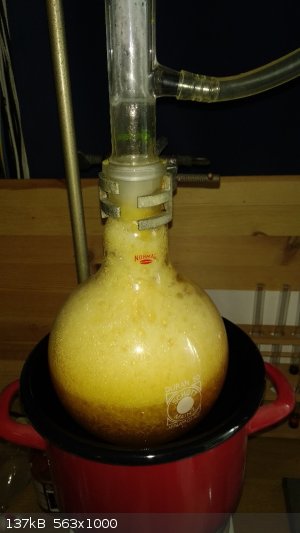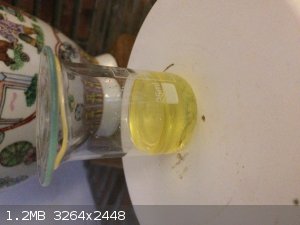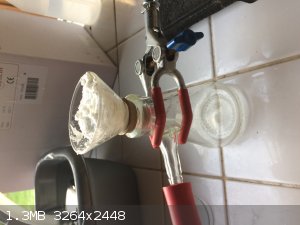| Pages:
1
..
4
5
6 |
Fyndium
International Hazard
    
Posts: 1192
Registered: 12-7-2020
Location: Not in USA
Member Is Offline
|
|
If anyone's interested, I could post detailed synthesis of BzH with HNO3. Did it a couple of times prior.
|
|
|
Mancival
Harmless

Posts: 9
Registered: 17-2-2019
Member Is Offline
|
|
Fyndium, I’m sure I’m not the only one who will appreciate a lot your contribution. Details coming from actual experience are invaluable. Thanks
in advance
|
|
|
Fyndium
International Hazard
    
Posts: 1192
Registered: 12-7-2020
Location: Not in USA
Member Is Offline
|
|
I might do a writeup, but sadly I don't have any pictures. I could, although, to the run again in close future in my sloppy days and take pics too.
They tell a lot, considering the process has many shades of yellow.
|
|
|
draculic acid69
International Hazard
    
Posts: 1371
Registered: 2-8-2018
Member Is Offline
|
|
Just to put it out there I've seen new formulation paint stripper has benzyl alcohol
where DCM used to be making bnzOH otc.
|
|
|
dawt
Hazard to Self
 
Posts: 74
Registered: 9-5-2016
Location: EU
Member Is Offline
Mood: fluorescent
|
|
Small update on the procedure I posted about on the previous page, using dilute H2O2 and an octamolybdate catalyst to oxidise benzyl alcohol:
Yield for the preparation of the catalyst was 93 %. I've also attempted to scale up the reaction 10x using 1.1 eq. of H2O2, and
while heating up the mixture kicked off a violent reaction when the bath temperature was only approx. 85–90 °C. Luckily I had my eye on the mixture
and was able to remove it from the oil bath the second it started acting up, and I had also used my longest condenser, but the bubbling nearly reached
the top nonetheless. The picture below was taken 5-10 min after the erruption started, and you can see the reaction was still quite vigorous. For the
workup I followed the same procedure as before and ended up with an 81 % yield, though I did have to abort the distillation with approx. 100 mL left
in the pot since it started foaming.
I suspect there's still a significant amount of benzyl alcohol and some benzoic acid in my product, so I'll purify it via the bisulfite adduct next.

|
|
|
Keras
National Hazard
   
Posts: 895
Registered: 20-8-2018
Location: (48, 2)
Member Is Offline
|
|
Here is another green path from benzyl alcohol to benzaldehyde. It is almost OTC, provided you can put your hands on Oxone (potassium
peroxymonosulfate).
Source : Oxone/Sodium Chloride: A Simple and Efficient Catalytic System for the Oxidation of Alcohols to Symmetric Esters and Ketones. Synthetic
Communications, 36: 1147–1156, 2006. DOI: 10.1080/00397910500514030
Oxone and sodium chloride can be used to either synthesise symmetric alkyl esters or aromatic aldehydes (non-enolisable).
EXPERIMENTAL:
31 g of Oxone (100 mmol) are dissolved into 150 mL of water in a 250 mL beaker using strong stirring. To this is added 6 g (100 mmol) of NaCl.
WARNING: upon addition, chlorine gas in released, so this must be conducted in a well ventilated area. Immediately after the sodium chloride has
dissolved, 10,8 mL of benzyl alcohol (d ~ 1, 100 mmol) is added to the mixture, which is left to stir at r.t. for 5 hours under a watch glass or
similar loose capping, to avoid sur-oxidation to benzoic acid. After a few minutes, the emulsion becomes greenish in colour, probably due to the
presence of dissolved chlorine gas.
After 5 hours of continuous stirring, the mixture is left to stand. The upper yellow layer containing benzaldehyde (strong aroma of almonds) and
unreacted benzyl alcohol (total: 11 mL) separates from the bottom aqueous layer containing salt and Oxone. The organic phase is collected, washed with
water twice. Pure benzaldehyde can be obtained using the bisulfate adduct method (with ~ 15 ml of a saturated solution of sodium bisulfate or
metabisulfate).
Pictures: separated upper layer before purification ; Washing of the bisulfite adduct with ethanol
 
[Edited on 31-10-2021 by Keras]
|
|
|
| Pages:
1
..
4
5
6 |